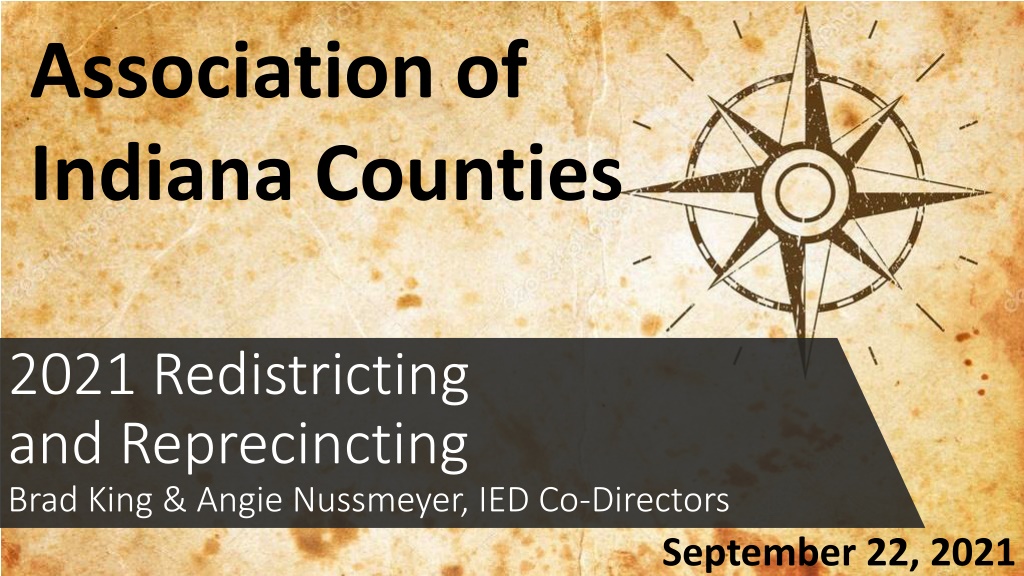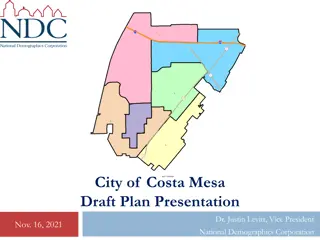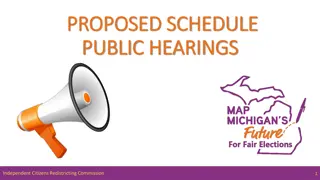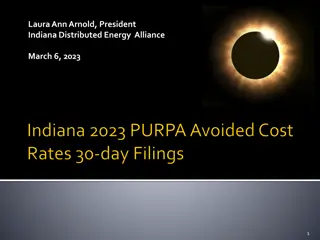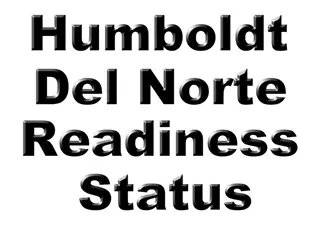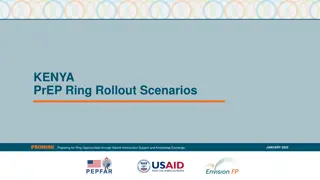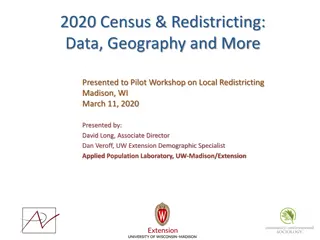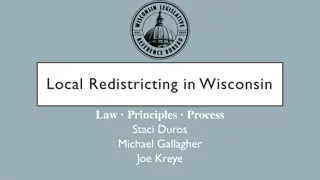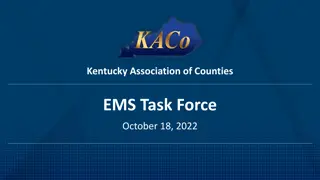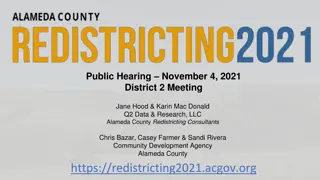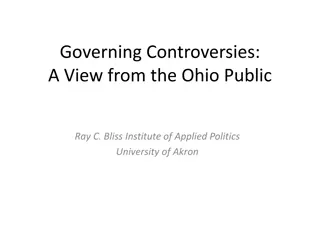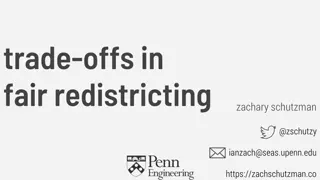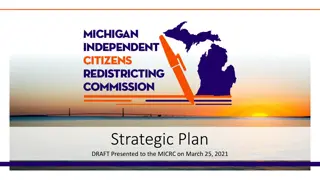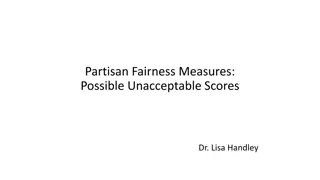Indiana Counties 2021 Redistricting and Reprecincting Updates
Indiana is undergoing redistricting and reprecincting based on the 2020 Census data. The process involves ensuring consistency between Census data and state databases, with adjustments made to precinct boundaries. Legislative schedules detail the proposed changes and the process for final approval. The final version of bills will be presented to key officials before becoming law.
Uploaded on Sep 18, 2024 | 2 Views
Download Presentation

Please find below an Image/Link to download the presentation.
The content on the website is provided AS IS for your information and personal use only. It may not be sold, licensed, or shared on other websites without obtaining consent from the author. Download presentation by click this link. If you encounter any issues during the download, it is possible that the publisher has removed the file from their server.
E N D
Presentation Transcript
Association of Indiana Counties 2021 Redistricting and Reprecincting Brad King & Angie Nussmeyer, IED Co-Directors September 22, 2021
State and County Redistricting State and County Redistricting The process has begun . U.S. Census Bureau provided results of 2020 Census using a legacy software format in August 2021 (rather than final version of data in February or March as in past years). More consumable text (.csv) file with same info was released to Census Bureau website on September 16. Census Bureau data is available at the state library. Contact: State Library Data Center Katie Springer 317-232-3732
Census Data Discrepancies County election officials have worked with county commissioners to make precinct names consistent between Census data and state databases. County election officials have compared detailed precinct boundary maps showing minor discrepancies between Census Bureau and state boundary maps: slivers of difference due to software versions. As of January 1, 2022, Census Bureau precinct boundaries will become legal boundaries of Indiana precincts. Counties can proceed to correct any significant problem using Census Bureau boundaries as base.
State Legislative Schedule House Bill 1581-2021 currently contains proposed new Congressional and Indiana House of Representative lines. House Elections Committee conducted hearings and voted bill out of committee on Monday, September 20, with the full House scheduled to consider amendments on Wednesday, September 22 and final passage on Thursday, September 23. State Senate district maps will be offered as second reading amendment to HB 1581 today (Wednesday, September 22). Senate Elections Committee to conduct hearings on HB 1581 on Monday, September 27 and Tuesday, September 28 Full Senate scheduled to consider amendments on Thursday, September 30 and final passage of HB 1581 on Friday, October 1.
Legislative Schedule Unknowns If ANY change made to HB 1581 in the Indiana Senate, the Indiana House must either concur (agree) to change, or appoint conference committee with Senate to reach agreement. When both House and Senate have agreed on language for HB 1581, the bill must be presented to the Governor for action.
Legislative Schedule Unknowns Presentation may not happen immediately: Final version of bills must first be signed by House Speaker, Senate President Pro Tempore, and Lieutenant Governor (as President of Senate). Governor has 3 options concerning any bill: sign the bill, veto the bill, or allow the bill to become law without Governor s signature. Indiana Constitution gives Governor 7 days to make decision after presentation . Any bill not signed or vetoed becomes law on 8th day after presentation. (Article 5, Section 14) We may know final district lines during week of October 4. But nothing CERTAIN until Governor acts.
What We Do Know House Bill 1581-2021 (if amended) will contain proposal to split precincts in 19 counties: Bartholomew (CD), Cass (CD), DeKalb (SD), Delaware (HD), Fountain (CD), Hamilton (HD and SD), Hendricks (HD), Howard (CD, HD, and SD), Johnson (HD and SD), Kosciusko (CD and SD), Lake (HD and SD), LaPorte (CD), Madison (HD), Marion (CD and SD), Owen (SD), Porter (HD), Randolph (CD), St. Joseph (HD), Warrick (HD)
What We Do Know No residence requirements for Congressional candidates. On November 7, 2021, Indiana Senate and House of Representatives district lines must be in place for candidates to be certain candidate will meet residence requirements. Article 4 Section 7 of the Indiana Constitution requires candidates to be inhabitants of the district for 1 year before the November 8, 2022 General Election.
Things We Do Know January 5, 2022 candidate filing begins for May and November 2022 elections. Precinct boundaries must be finalized because we will have Democrats filing for precinct committeeman election in May 2022 primary and All other candidates have to indicate which precinct they are a resident of when they file.
Redistricting and Reprecincting If congressional district or state legislative districts split some current precincts in your counties, new precincts will have to be established since no precinct may cross a congressional or state legislative district line. Even in counties with no split precincts, some or all voter registration records in the county will have to be altered to reflect voter s assignment to new election districts. This must be done by January 5, 2022 - First date for candidate filing. Other county district changes (such as county commissioner and county council redistricting) may also require changes in precincts and voter records. Redistricting will require county election officials to work with Election Division and Secretary of State to make certain both boundaries and registration records are accurate.
County Council Redistricting (Most Counties) 4 single-member districts/ 3 at-large seats Single member districts are established by Co. Commissioner Ordinance (IC 36-2-3-4; IC 36-2-3-4.7) Districts must be compact subject only to natural boundaries (roadways, railroads, waterways etc.) Districts must contain, as nearly as possible, equal population. District boundaries must not cross a precinct boundary. Districts must include whole townships, except when division is clearly necessary to accomplishing redistricting.
Lake County Council Lake County Council Districts established by Indiana Election Commission Order acting as ( Lake County Redistricting Commission ), plus 4 state legislative advisory members. 7 Single Member Districts. Required to have equal population. Subject to same standards as other county council districts in all other counties except Marion and St. Joseph. Marion County has city-county council not a county council under a different law. City-County council redistricting in 2022.
St. Joseph County Council St. Joseph County Council established by county council ordinance. 9 single member districts. Required to have equal population. 3 of county council districts must be contained within 3 county commissioner districts. (nesting) Subject to same standards as county council districts in all other counties except Marion and Lake.
County Commissioner Redistricting (Most Counties) 3 districts are established by Co. Commissioner Ordinance (IC 36-2-2-4 and 36-2-2-4.7) Districts must contain contiguous territory. Districts must be reasonably compact . Not required to have equal population in most counties. District boundaries must not cross precinct boundary lines and must divide townships only when a division is clearly necessary to accomplish redistricting. (IC 36-2-2-4)
Lake County Commissioners Lake County Commissioner Districts Established by Indiana Election Commission Order acting as ( Lake County Redistricting Commission ), plus 4 state legislative advisory members. 3 Single Member Districts. Required to have equal population. Subject to same standards as other county commissioner districts in all other counties except Marion and St. Joseph.
St. Joseph County Commissioners St. Joseph County Commissioners established by commissioner resolution. 3 single member districts. Required to have equal population. Subject to same standards as county commissioner districts in all other counties except Marion and Lake. Marion County does not have separately elected commissioners. Mayor of Indianapolis is Marion County executive under Unigov.
Vacancies; District Descriptions in Ordinances Previously adopted ordinance establishing districts remains in effect for the purpose of filling a vacancy in office until the expiration of the term of that office. (36-1-6-10) A reference in the ordinance to an existing boundary (a precinct, for example) refers to the precinct as it existed on the date of adoption of the ordinance. A change in the precinct boundary after adoption of the ordinance does not alter the boundaries of the election districts established by the ordinance. (IC 36-1-6-10)
Redistricting Ordinances (Finer points) Existing districts can be recertified by adopting ordinance stating that the existing districts comply with law and remain effect. Unanimous consent required to pass ordinance at same day it is introduced (IC 36-2-4-7). St. Joseph County commissioner resolution requires two meetings in any case (IC 36-2-2-4.7) Ordinance requires map of districts (in addition to legal descriptions). If there is conflict, words prevail over maps. Ordinance must be filed with county clerk (IC 36-2-2-4; 36-2-3-4) and auditor (IC 36-2-4-9), but no legal notice publication required (IC 36-1-5-3).
Redistricting Ordinances (Finer points) Care needed with effective dates of repeal of prior ordinances and county code provisions. Recognize that existing county commissioner ordinances have continuing effect for members elected in 2020. (IC 36-1-6-10)
Who Establishes Precincts? Precincts are established by the following people: The County Commissioners. Combined Boards of Election and Registration in Lake, Porter, and Tippecanoe Counties. In some cases, the Indiana Election Commission, if precinct boundary crossing election district line in violation of state law.
What is the Process for Establishing Precincts The County Commissioners propose a precinct establishment order. IED performs technical review of precinct proposals after Office of Census Data (OCD), [part of Legislative Services Agency] review. If a county voter files a timely objection after legal notice of IED approval is published by the county, Indiana Election Commission (IEC) will determine whether to approve precincts. IEC may approve precinct changes if there is not sufficient time for a 10 day objection period.
What is the Process for Establishing Precincts Establishing precincts requires the proper paperwork. Order from the County Commissioners. Completed IEC-8s describing precinct changes. At some point precinct GIS shape files are laid over census Tiger Files that allow census block listing to be printed for each precinct. State plans to implement optional paperless county precinct change module in SVRS this year.
What is the Process for Establishing Precincts? Establishing precincts involves several steps but the IED can help with sample forms and technical assistance. IED will assign a precinct coordinator to help guide a county through the process. IED will issue memos along the way (For example, IED will provide specific instructions upon approval of precincts regarding follow-up procedures).
Are Any Precinct Changes Automatic? Precincts may not be established by any other people or by any other process. Precinct boundaries are not automatically altered when the General Assembly or a county, municipality, or school district establishes new election districts. Precincts are not automatically altered when a city or town annexes new territory.
Additional Precinct Technical Standards Active Voter limits (IC 3-11-1.5) see active voter definitions IC 3-5-2-1.7(1) Minimum of 600 active voters with some exceptions and grandfathering. Not less than 600 active voters. Grandfathered if established before July 1, 2019. Exempted if precinct is entire county commissioner, county council district, or city or town council district, or entire township, city or town. Not more than 2,000 active voters. Exceptions are if it is the entire township or entire city or town council district or one residential structure with more than 2,000 active voters then limit is raised to 2,300 active voters. Precincts in certain university campuses, if less than 40% of active voters voted in the last primary, then there is no limit. When establishing precincts your precincts MUST follow these boundaries and may NEVER cross these boundaries: No precinct may cross a congressional, state legislative or township boundary. No precinct may cross the state boundary or a county boundary or a township boundary.
Municipal Annexation Annexation ordinance must assign annexed area to council district in a city or town (if any). Voters in annexed area are eligible to vote in city or town elections once the annexation is final. (IC 3-11-1.5-33) However, an annexation by a city or town does not automatically change any of your precincts. Remember- Only county commissioners or IEC can change precinct boundaries.
Batch Changes to Voter Registration Records Counties are responsible for making changes in individual voter records but can authorize the state to make batch changes to all voter registration records in a specific township or precinct or the entire county to reflect new district lines rather than county make changes one record at a time.
